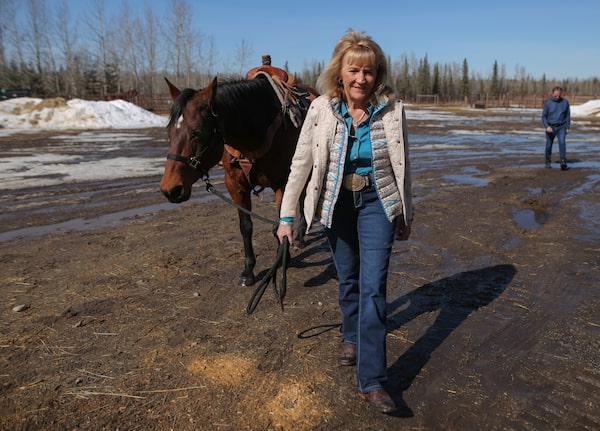
Fifth-generation rancher Mary Robinson on her property Moose Hill Ranch, along the Elbow river near the western edge of Calgary, AB., on March 22, 2019. Robinson is concerned about what will happen to her land if the Springbank Dam goes ahead.Leah Hennel/The Globe and Mail
A flood-protection project upriver from Calgary, stalled by years of regulatory delay, has become a campaign issue as Jason Kenney and Rachel Notley say the other does not have a credible plan to protect Alberta’s largest city from the type of deluge that swept through nearly six years ago.
Mr. Kenney, the United Conservative Party Leader, is seeking to unseat Ms. Notley and her New Democrats on April 16.
The proposal to build a massive dam and dry reservoir on the Elbow River has been slowed by protest from local landowners and First Nations, who contend the project isn’t sound and that better alternatives exist. The dam proposal has divided local politicians for years and some in Mr. Kenney’s party have suggested the project should be cancelled. No substantial barriers have been built on the Elbow River since the 2013 flood, which was one of the costliest disasters in Canadian history and left central Calgary under water for days.
The UCP Leader has said he’d proceed with construction if he gets environmental and First Nations approval. However, local ranchers say they hope Mr. Kenney will heed the criticism from his local candidate and turn his back on the project.
“This river is an evil thing and it torments us all the time,” said Mary Robinson, a rancher who lives and works on 600 acres of land west of Calgary that borders the Elbow River. The land, where her family has ranched since 1888 and where she was born in a log cabin, would be submerged by the dam proposal.
“All this land is what makes this area special for us and the dam would take it all. We’d be devastated. It’s just take my home, my job and my livelihood,” she said. “If the UCP was smart, they’d lean on this.”
After announcing plans for $1-billion of flood protection on the Bow River, Ms. Notley said on Friday that Mr. Kenney’s proposal to look at the dam project would cause further delay. “It’s a complex project. That’s why the last thing we can afford is to press reset,” she said. The project is currently being reviewed by the Canadian Environmental Assessment Agency.
The Springbank dam project would see the construction of a dry reservoir where excess water from the Elbow River would be diverted onto nearly 16 square kilometres of ranch land. The area, in the foothills of the Rocky Mountains west of Calgary, would absorb the water before it rushed into the neighbouring city of more than 1.2 million.
An area nearly 1½ times larger than Calgary’s Nose Hill Park would be largely closed to the public and left dry, ready to receive flood waters coming down from the mountains.
Among the horses and cows wandering the fields where the dam would be built are signs posted by defiant ranchers on barbed-wire fences opposing the project.
Miranda Rosin, the UCP’s candidate in the Banff-Kananaskis riding where the project would be built, said in an online post that she would fight the dam as a “vocal opponent.” Calgary Mayor Naheed Nenshi said her position was only “pandering for votes" and that he has been a strong supporter of the proposal.
Speaking with reporters in Calgary on Thursday, Mr. Kenney said his party, if elected, would appoint an expert to look into the project and see why it has been delayed. The proposal was first given the green light by former Progressive Conservative premier Jim Prentice in 2015 and then also approved by Ms. Notley’s New Democrats after they won election later that same year.
Despite statements from UCP candidates opposing the project and his party’s own proposal to create an act protecting property rights, Mr. Kenney said he would be open to expropriation to get the dam built.
“The government has to ultimately build critical public infrastructure,” Mr. Kenney said. “Ultimately, if the environmental assessment agency approves this and if the First Nations also give their consent following legitimate consultations, then we would proceed.”
Chief Lee Crownchild of the Tsuut’ina Nation said the Alberta government has not been forthcoming with details about the dam in an area important to the First Nation. He’s asked the government to consider alternative proposals that could have less of an impact on his community.
“At the heart of our rights has always been the connection to the land, water and resources within our traditional territory. We rely on that for our livelihood, language and culture. It’s all connected. This project is in the middle of our traditional territory in a place where we exercise those rights,” he said.
Lee Drewry, who owns 320 acres of ranch land with his wife on the northern edge of the proposed reservoir, said he hopes Mr. Kenney’s expert tells him to reconsider the proposal.
“I’m confident an independent investigator would say this is crazy. I don’t see how they’d come to any other conclusion,” he said.
 Justin Giovannetti
Justin Giovannetti